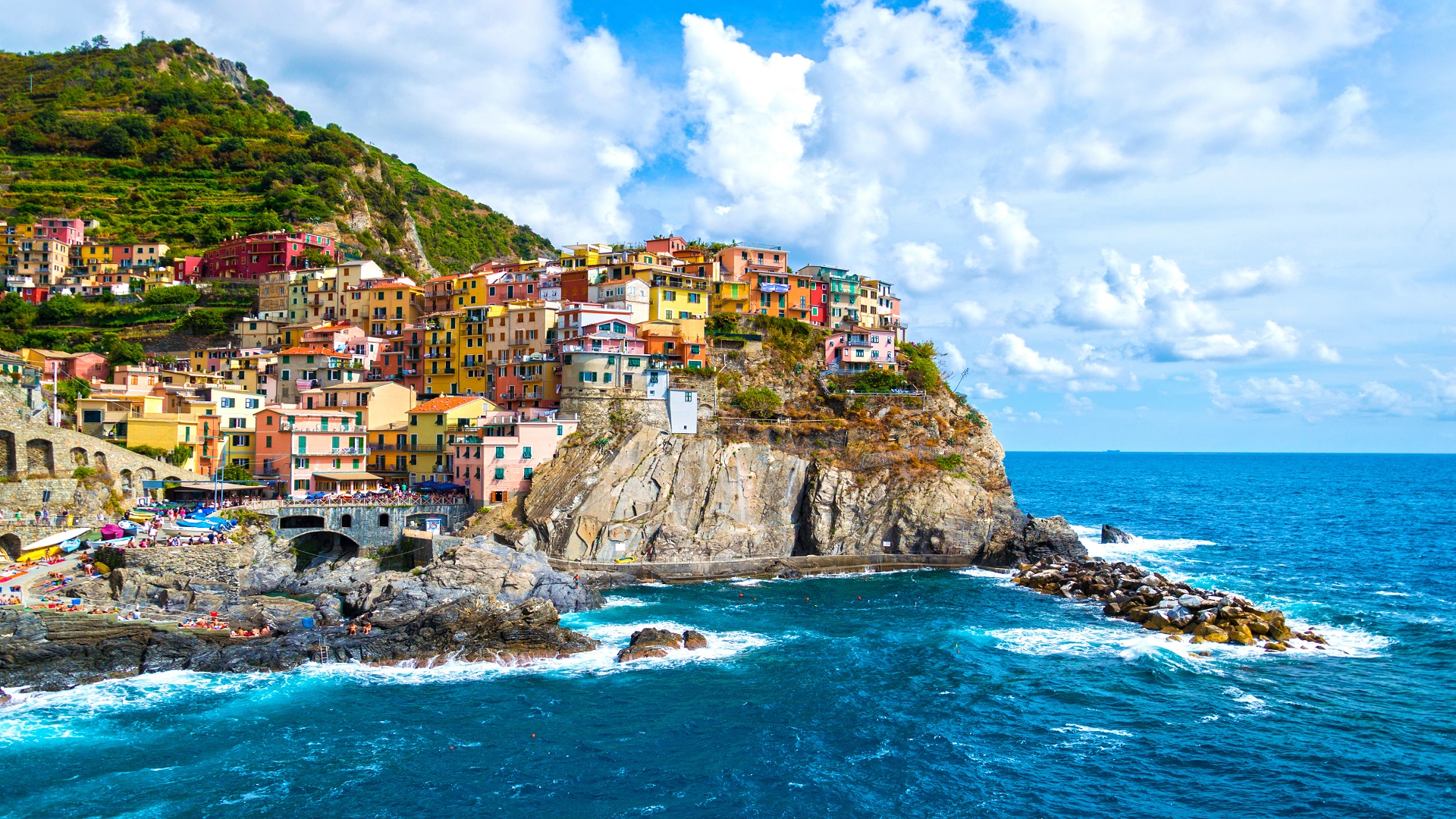Cinque Terre National Park
The Cinque Terre National Park, formally established in 1999, extends over an area of 3,869 hectares, making it one of the smallest in Italy, and includes Pelagos Sanctuary for Mediterranean Marine Mammals and a Protected Marine Area.
Over a thousand years of human settlements have shaped the typical structure of terraces, supported by dry-stone walls, and making this landscape one the most distinguishable in the world, reason for which it is also called the Park of Mankind. The territory features hills descending rapidly towards the sea. This national park begins behind Portovenere and continues towards Genoa, where the rugged landscape gives way to small creeks: these are the Cinque Terre (literally, Five Lands), five small treasures set between sea, rocks, and vineyards. Since 1997, the Cinque Terre, namely Riomaggiore, Manarola, Corniglia, Vernazza and Monterosso al Mare have been UNESCO heritage.
This natural park can be divided into three sections: the costal area, stretching along the coast and being the core of the national park, the marine area, and the protected natural area where the ridges of the hills are covered in typical Mediterranean vegetation.
Riomaggiore, Manarola and Corniglia hold an uphill position, whereas Vernazza and Monterosso al Mare are right at sea level: these five historical villages mark this territory featuring steep trails, rows of vines, and dry-stone walls.
In Riomaggiore, you will see the Chiesa di San Giovanni Battista (Church of Saint John the Baptist), dating back to 1340. The Via dell’Amore (literally, the Love Walk), connects Riomaggiore to Manarola.
In Corniglia, you will see the beautiful Chiesa di San Pietro (Saint Peter’s Church), built by the Antelami’s family, great master craftsmen, while in Vernazza visitors will have the possibility to see the Chiesa di Santa Margherita di Antiochia (Saint Margaret of Antioch’s Church).
The village of Monterosso has two cores: on one side, there is the historical nucleus, arranged around the Chiesa di San Giovanni Battista (Saint John the Baptist’s Church), whereas on the other side there is the modern part of Monterosso, named Fegina. Monterosso is home to many nationally and locally relevant points of interest: for example, the Capuchin Monastery, the Montale family home, whose most famous exponent, Eugenio Montale, was an internationally-celebrated poet who also won the Nobel Prize for Literature in 1975, and the Cinque Terre’s Literary Park.
Over a thousand years of human settlements have shaped the typical structure of terraces, supported by dry-stone walls, and making this landscape one the most distinguishable in the world, reason for which it is also called the Park of Mankind. The territory features hills descending rapidly towards the sea. This national park begins behind Portovenere and continues towards Genoa, where the rugged landscape gives way to small creeks: these are the Cinque Terre (literally, Five Lands), five small treasures set between sea, rocks, and vineyards. Since 1997, the Cinque Terre, namely Riomaggiore, Manarola, Corniglia, Vernazza and Monterosso al Mare have been UNESCO heritage.
This natural park can be divided into three sections: the costal area, stretching along the coast and being the core of the national park, the marine area, and the protected natural area where the ridges of the hills are covered in typical Mediterranean vegetation.
Riomaggiore, Manarola and Corniglia hold an uphill position, whereas Vernazza and Monterosso al Mare are right at sea level: these five historical villages mark this territory featuring steep trails, rows of vines, and dry-stone walls.
In Riomaggiore, you will see the Chiesa di San Giovanni Battista (Church of Saint John the Baptist), dating back to 1340. The Via dell’Amore (literally, the Love Walk), connects Riomaggiore to Manarola.
In Corniglia, you will see the beautiful Chiesa di San Pietro (Saint Peter’s Church), built by the Antelami’s family, great master craftsmen, while in Vernazza visitors will have the possibility to see the Chiesa di Santa Margherita di Antiochia (Saint Margaret of Antioch’s Church).
The village of Monterosso has two cores: on one side, there is the historical nucleus, arranged around the Chiesa di San Giovanni Battista (Saint John the Baptist’s Church), whereas on the other side there is the modern part of Monterosso, named Fegina. Monterosso is home to many nationally and locally relevant points of interest: for example, the Capuchin Monastery, the Montale family home, whose most famous exponent, Eugenio Montale, was an internationally-celebrated poet who also won the Nobel Prize for Literature in 1975, and the Cinque Terre’s Literary Park.
Interesting facts
 T
T
he Cinque Terre Natural Park includes nature and literary trails of the Parco Letterario Eugenio Montale (literally, Eugenio Montale Literary Park), a combination of Mediterranean landscapes and of a long tradition of poets and artist who immortalized this territory. This Literary Park, thanks to a collaboration with the Parchi Letterari Italiani (literally, Italian Literary Parks) networks and with the Società Dante Alighieri (literally, Dante Alighieri Society), offers an itinerary to discover the areas and symbols praised in their masterpieces.
Loading...
titolo popup
descrizione popup


